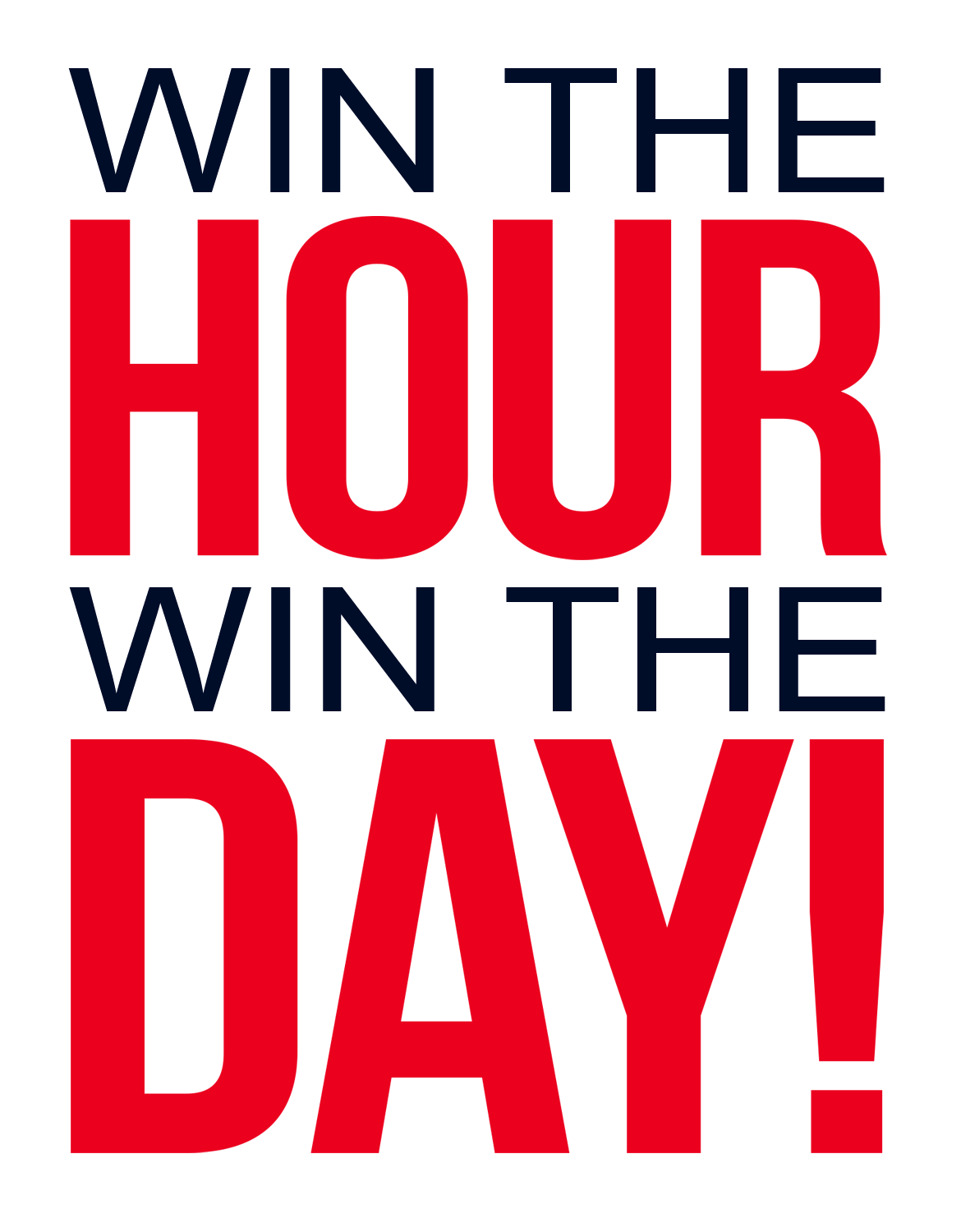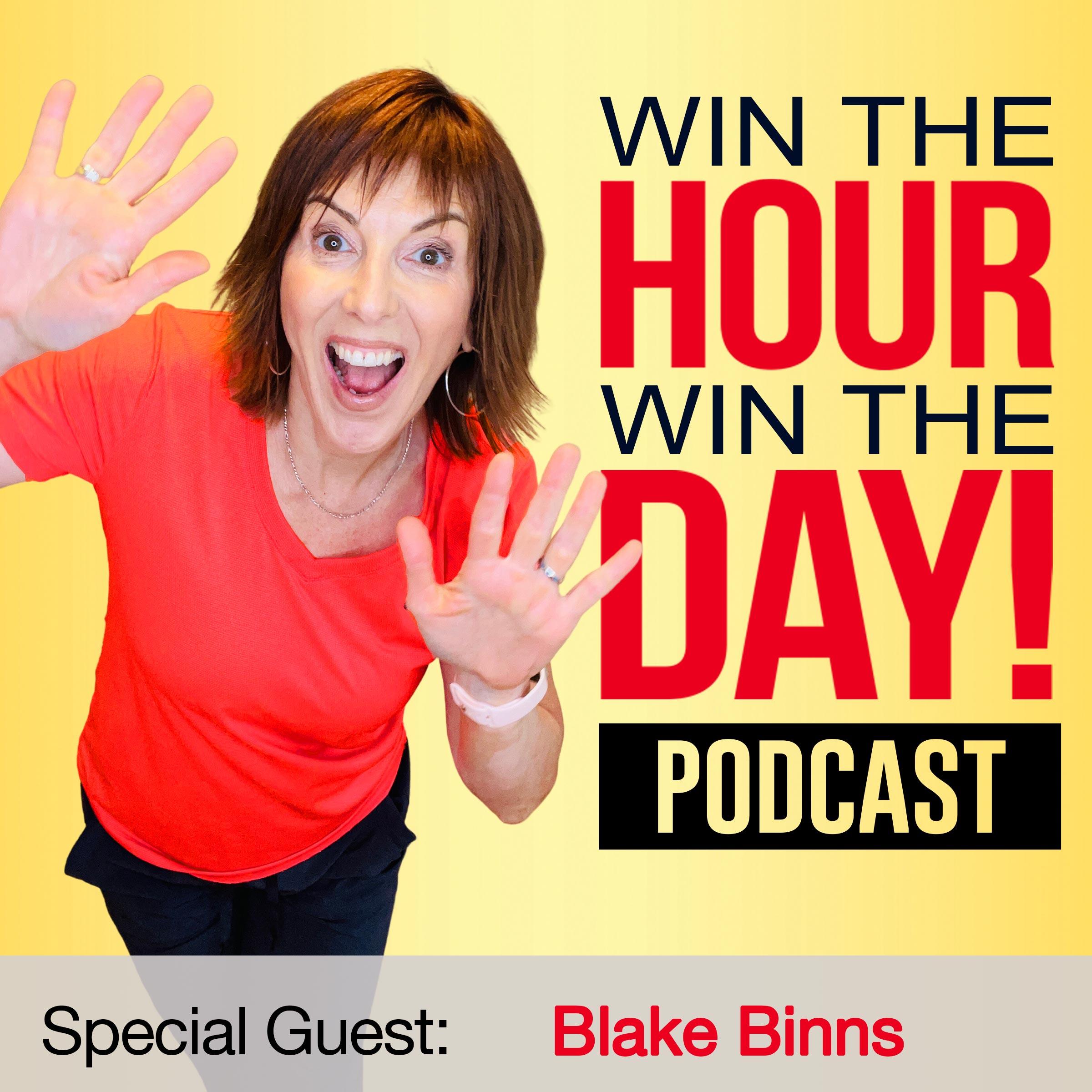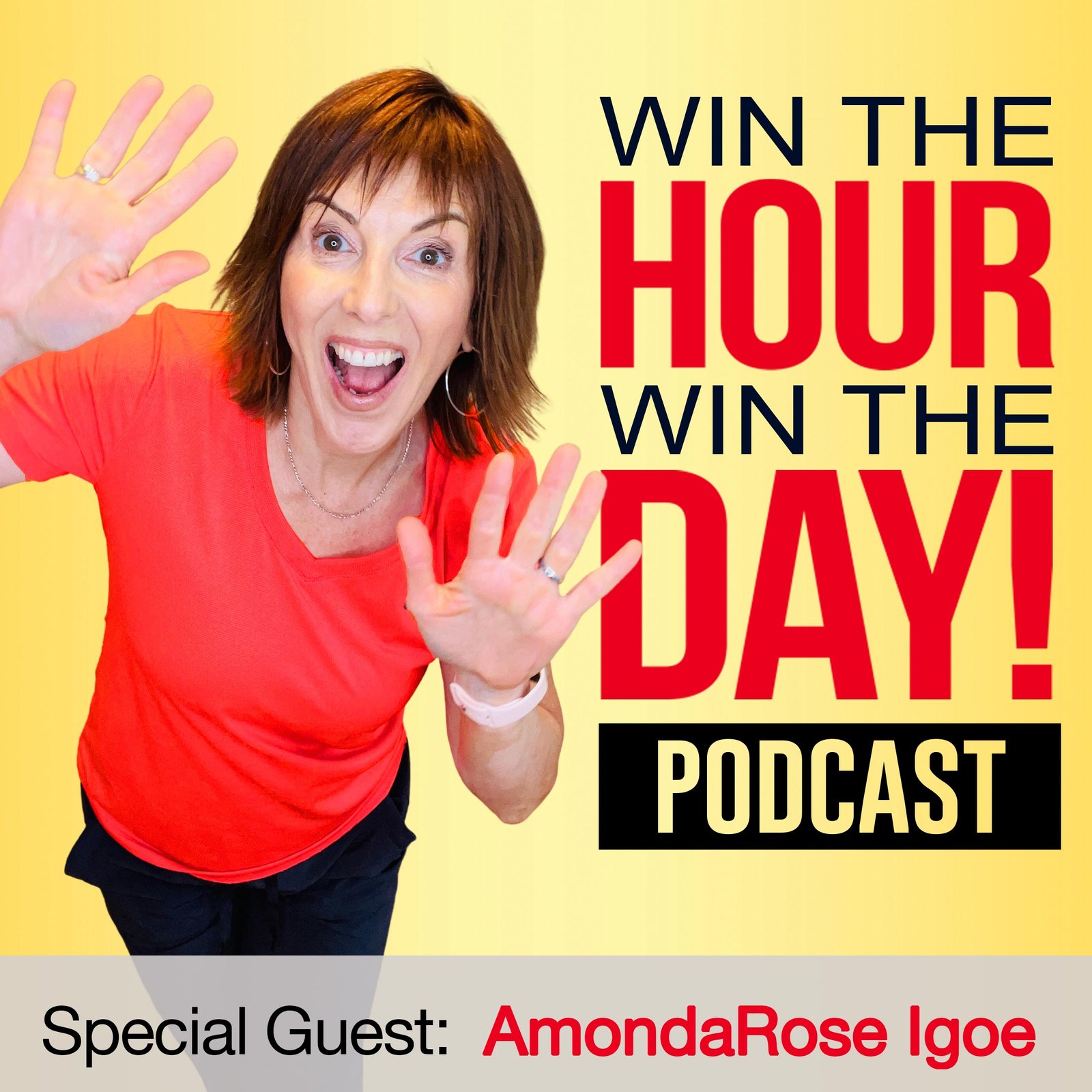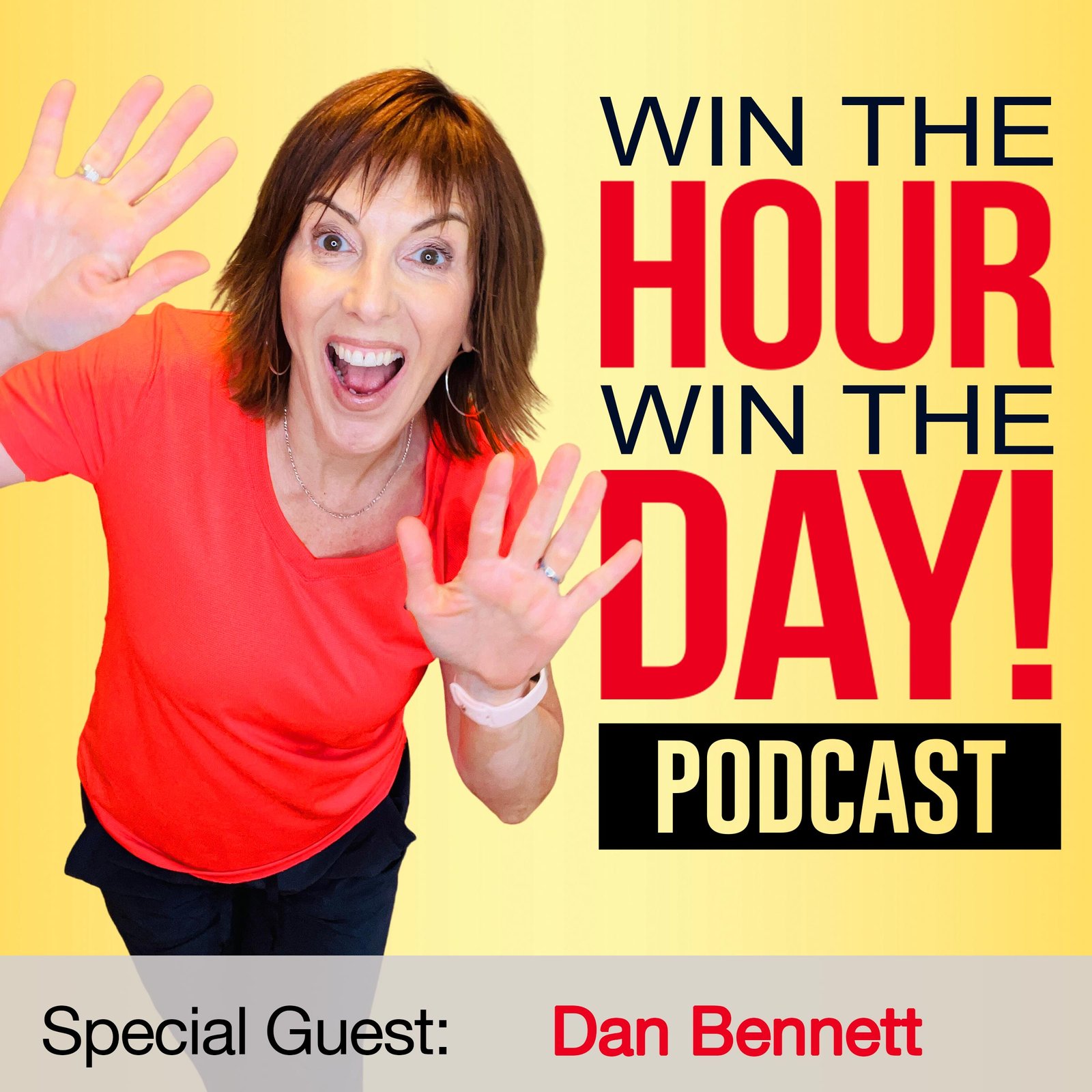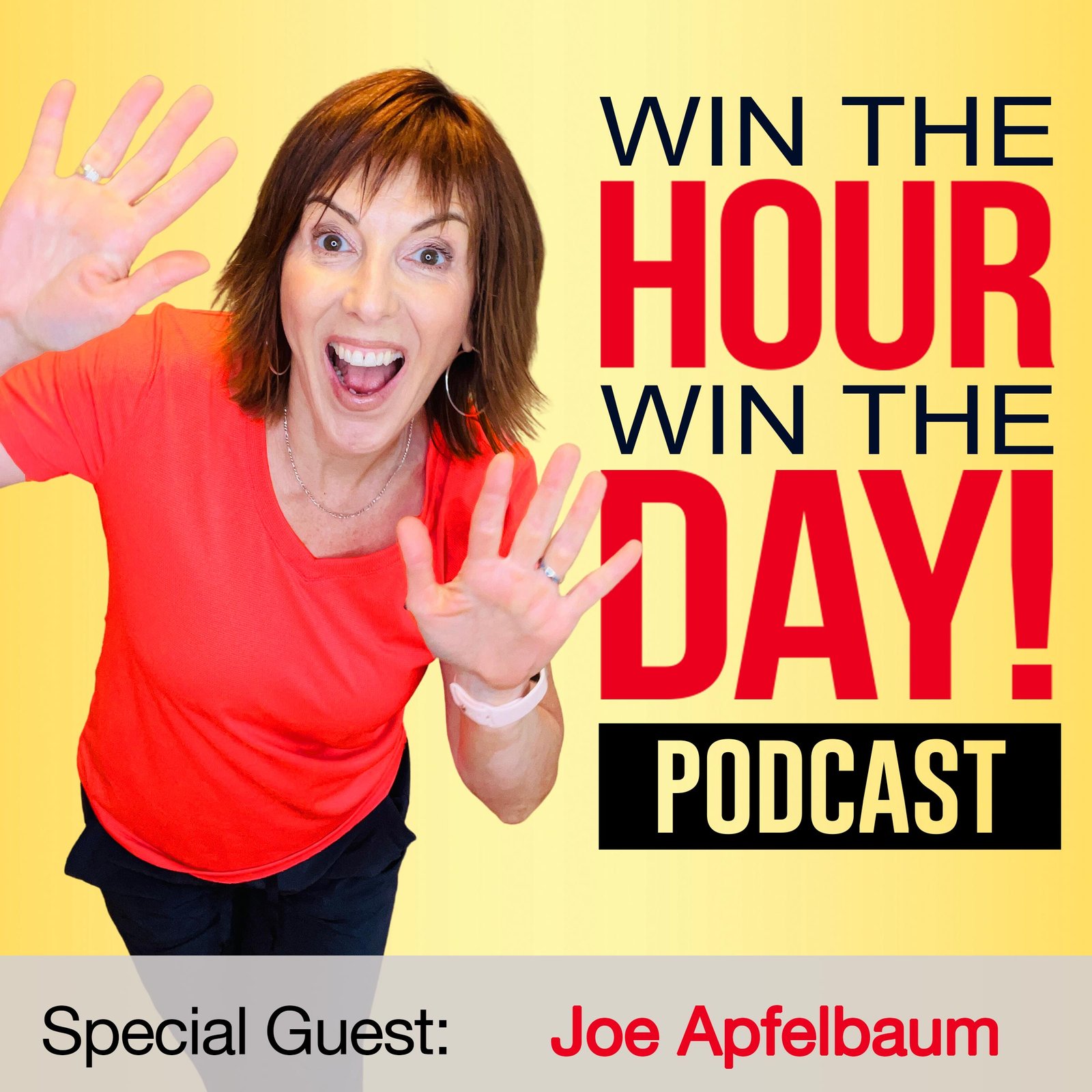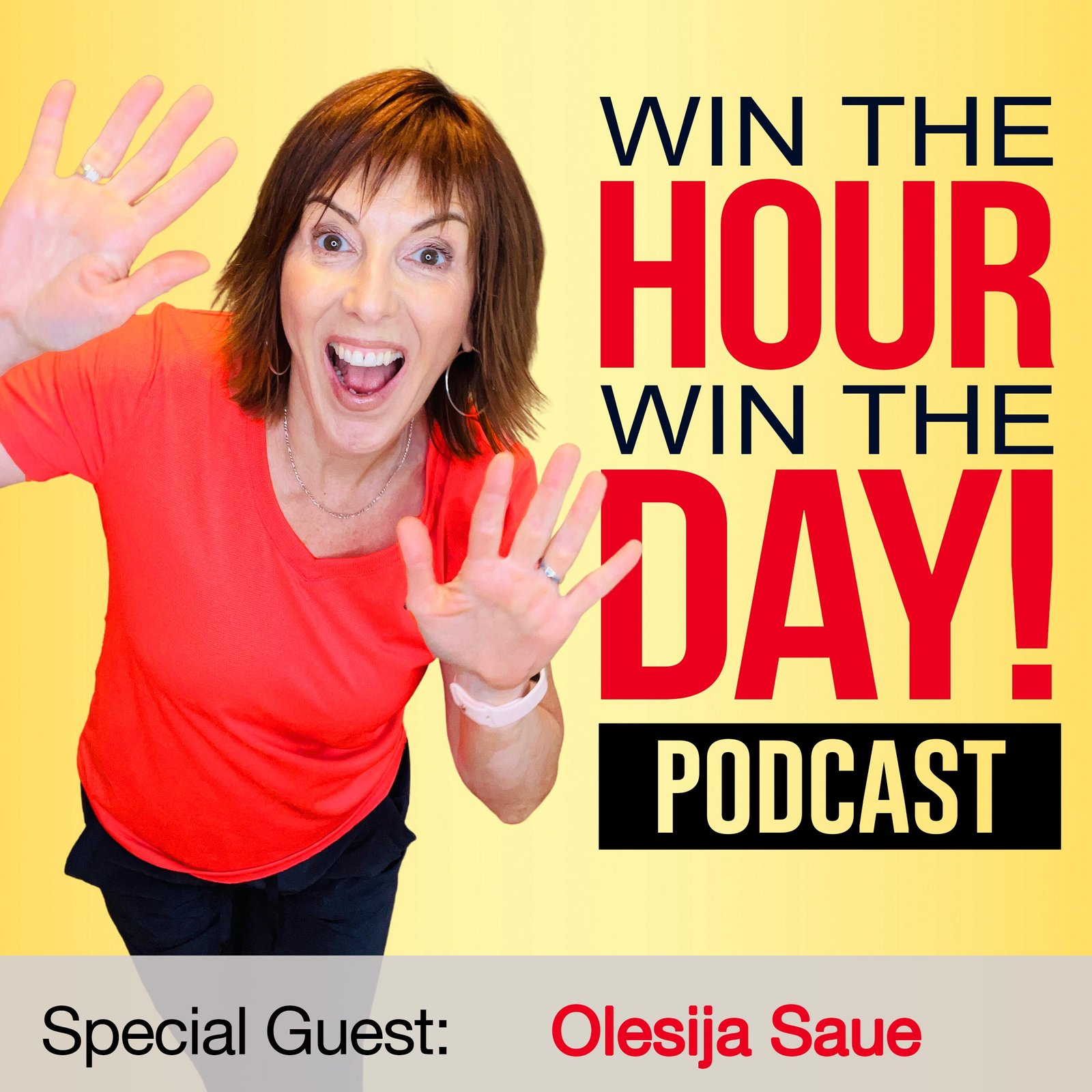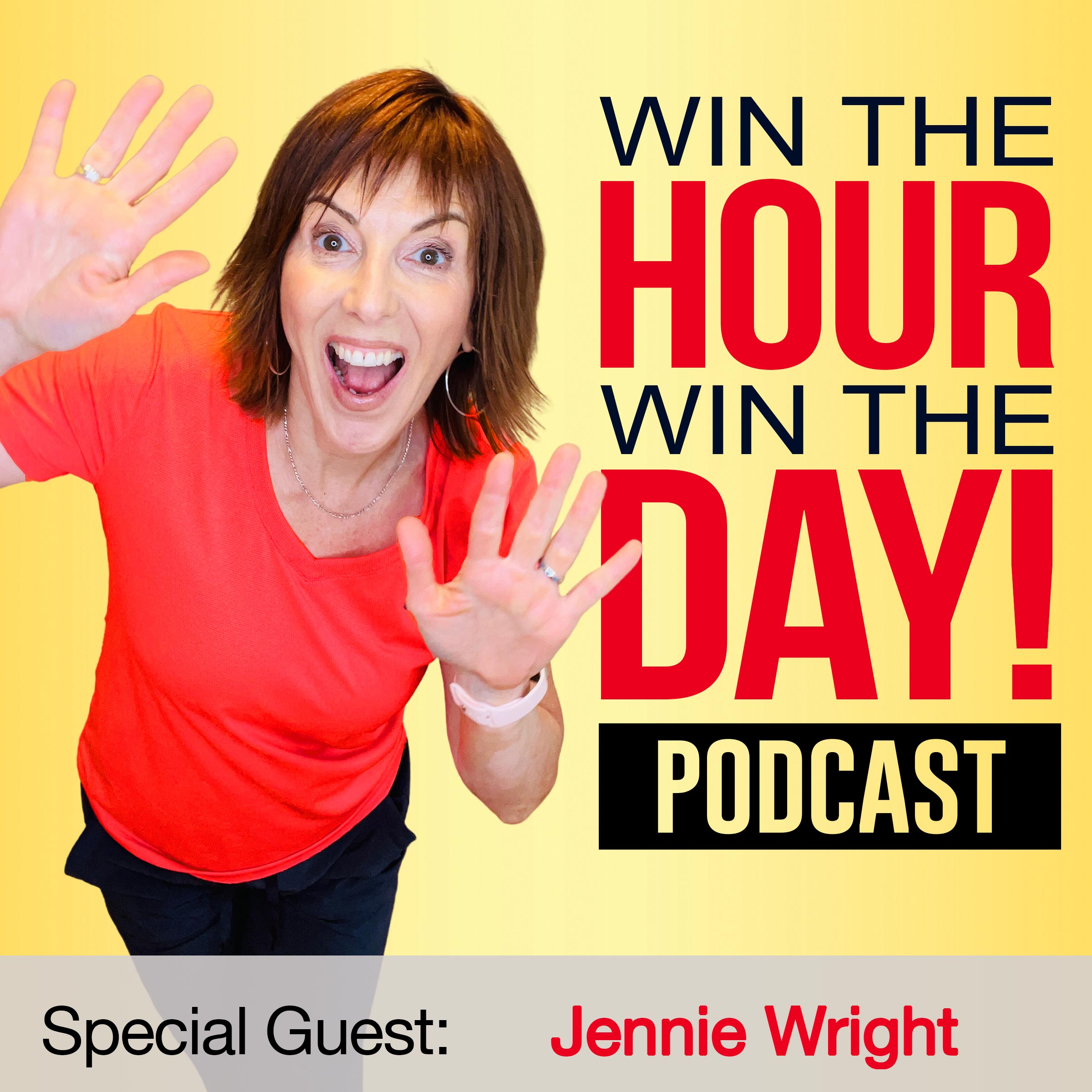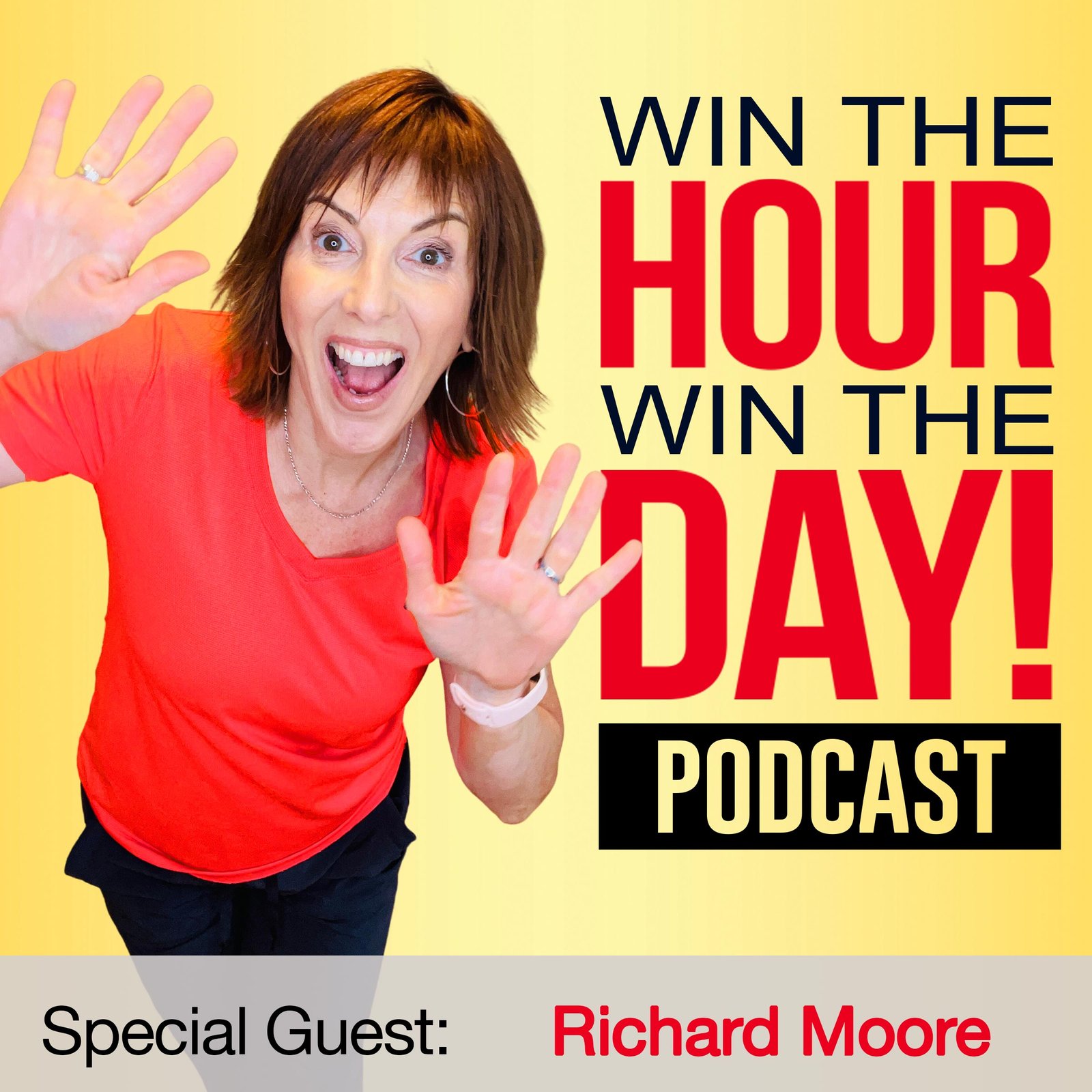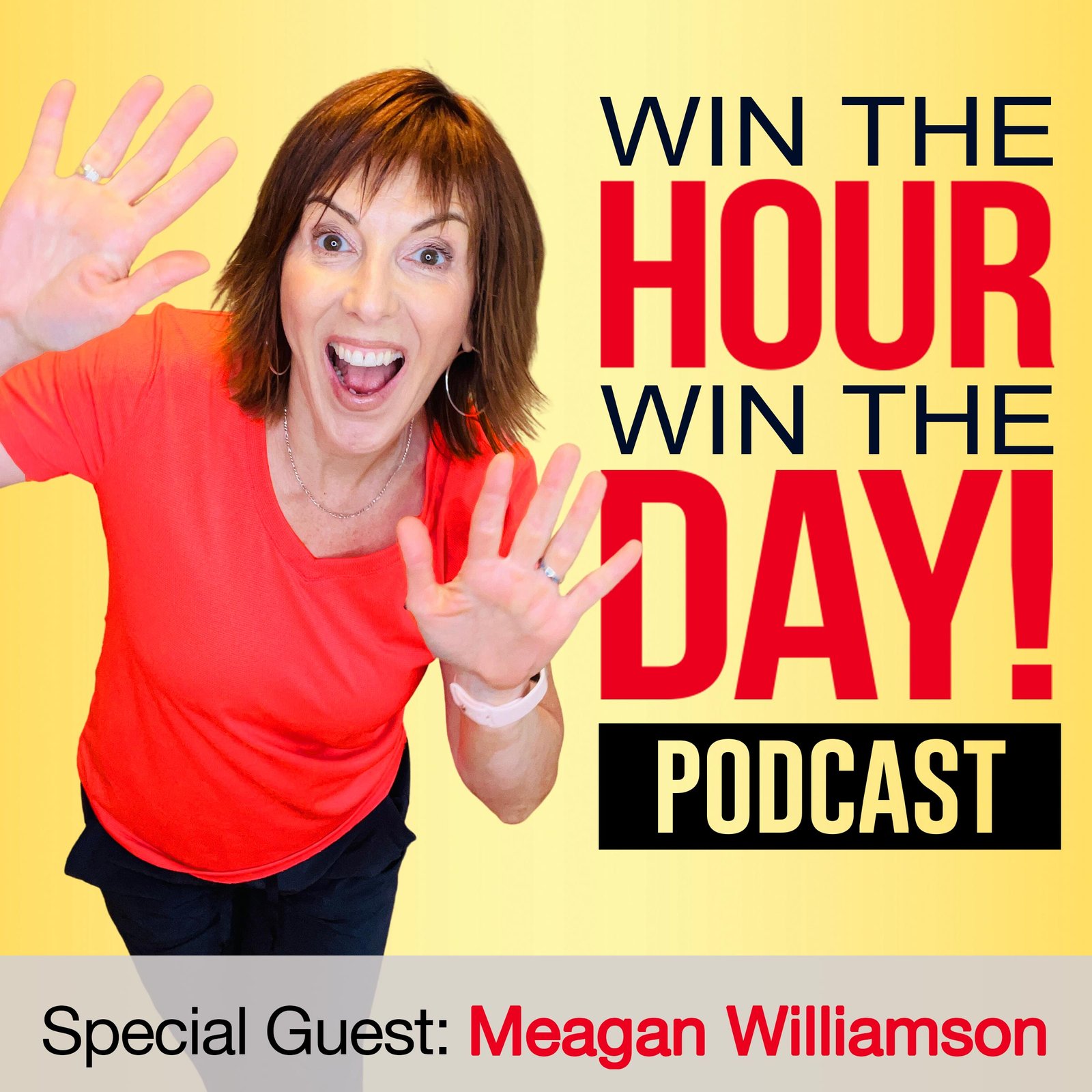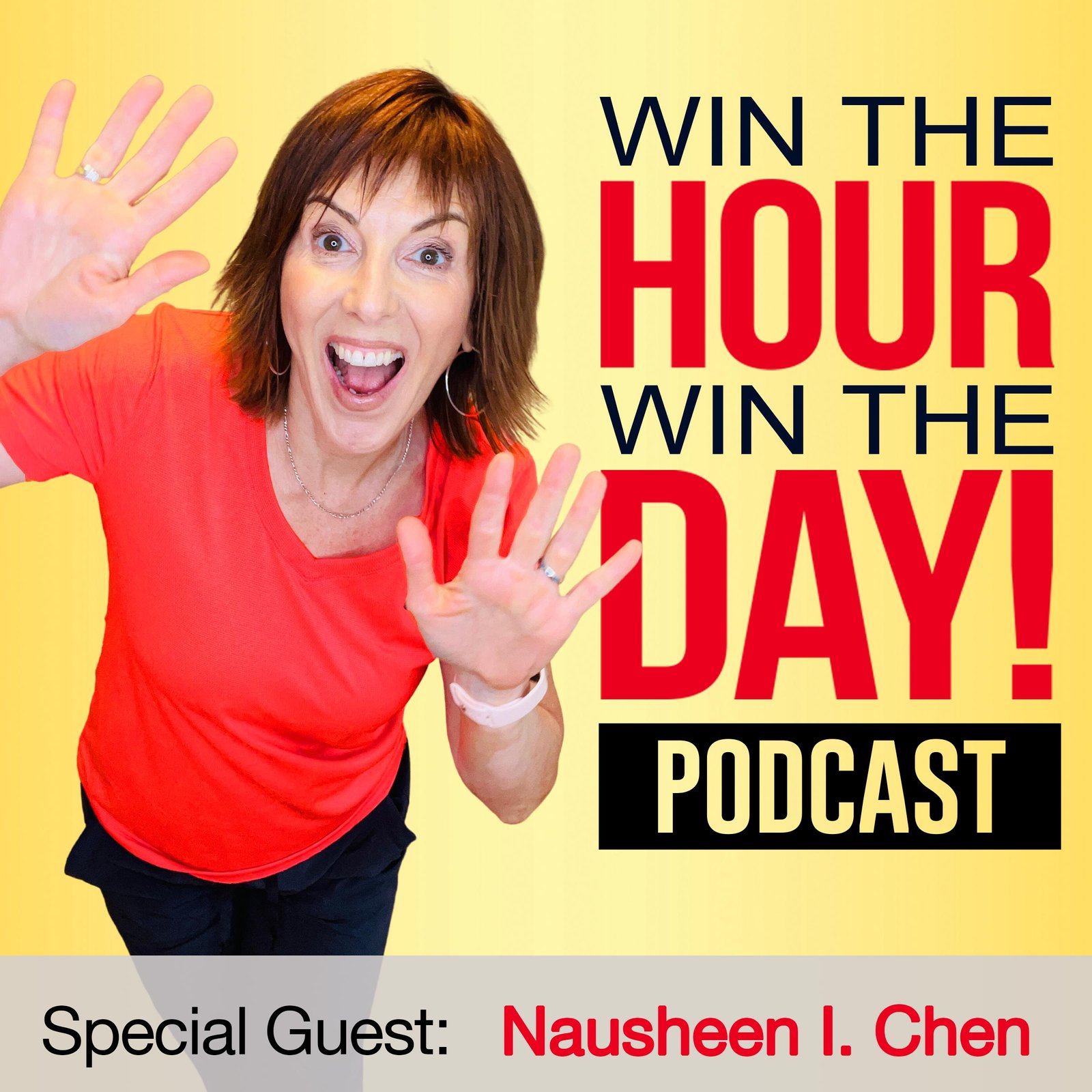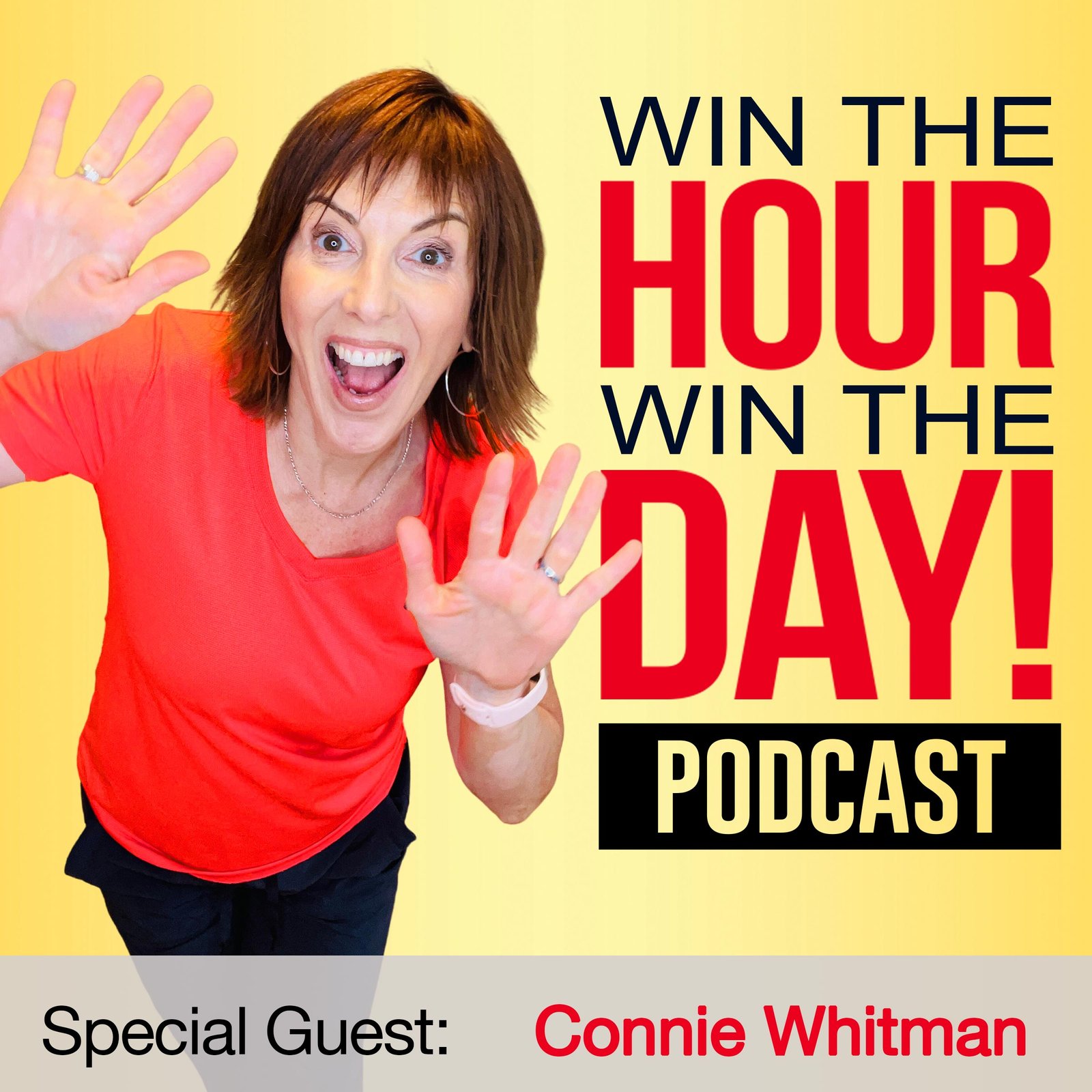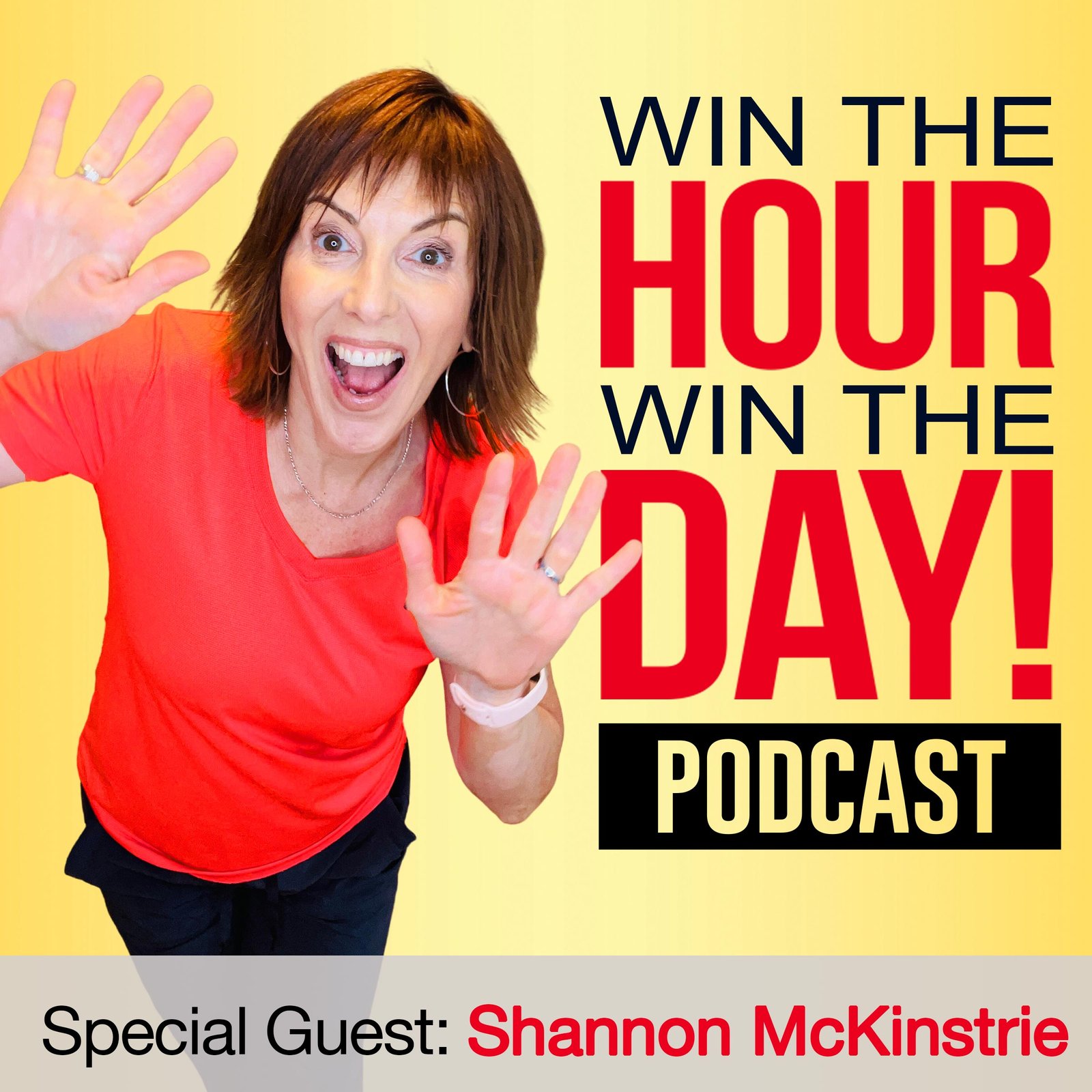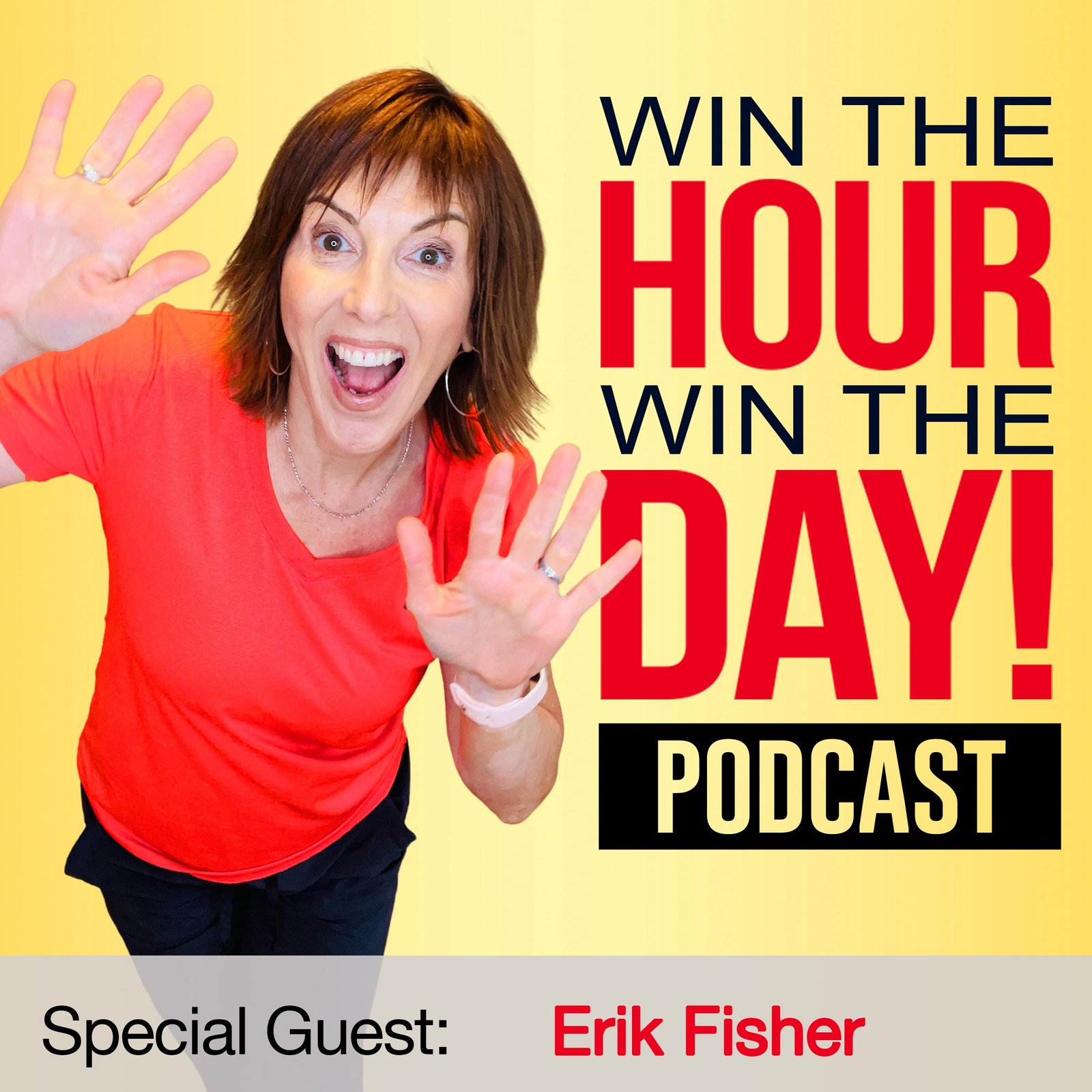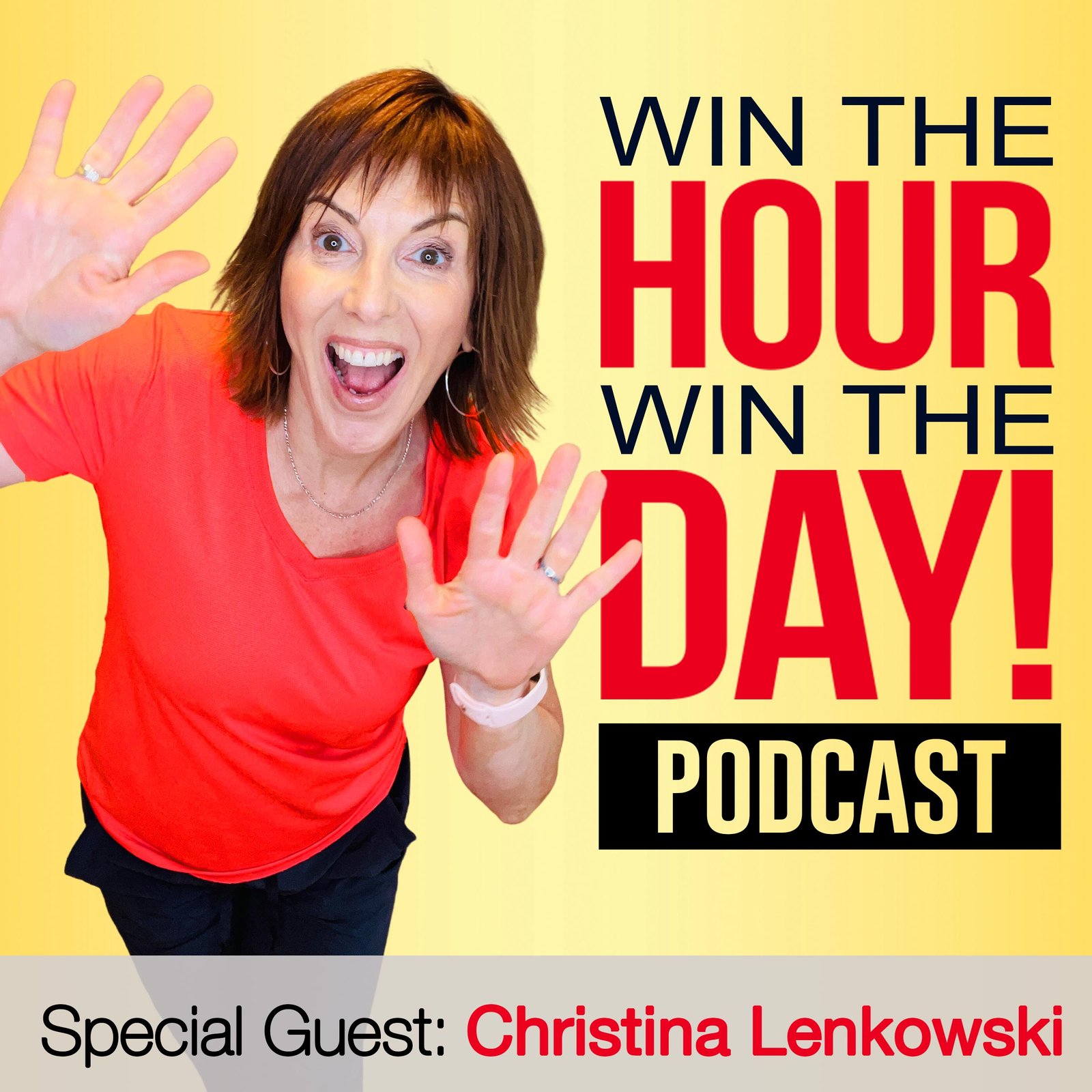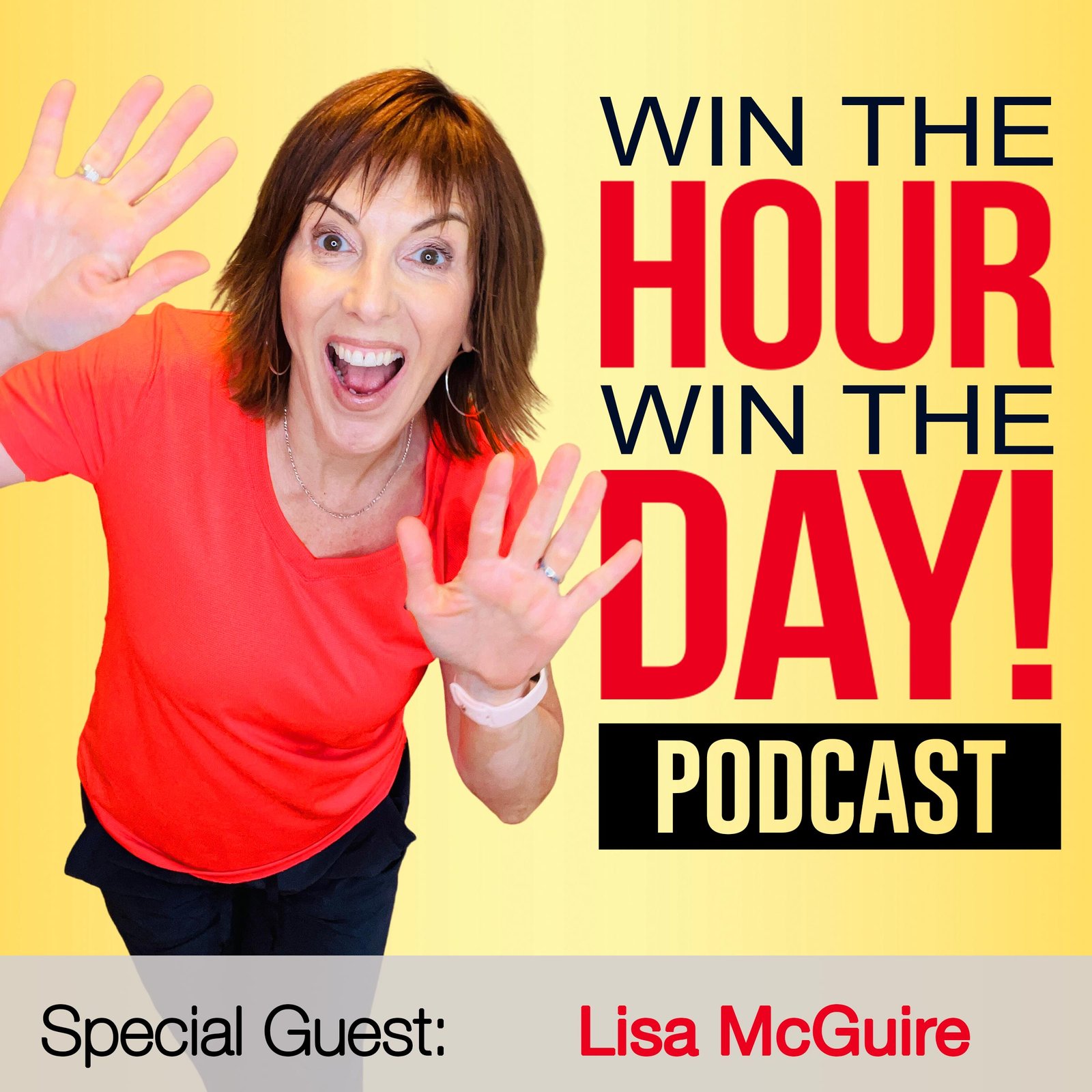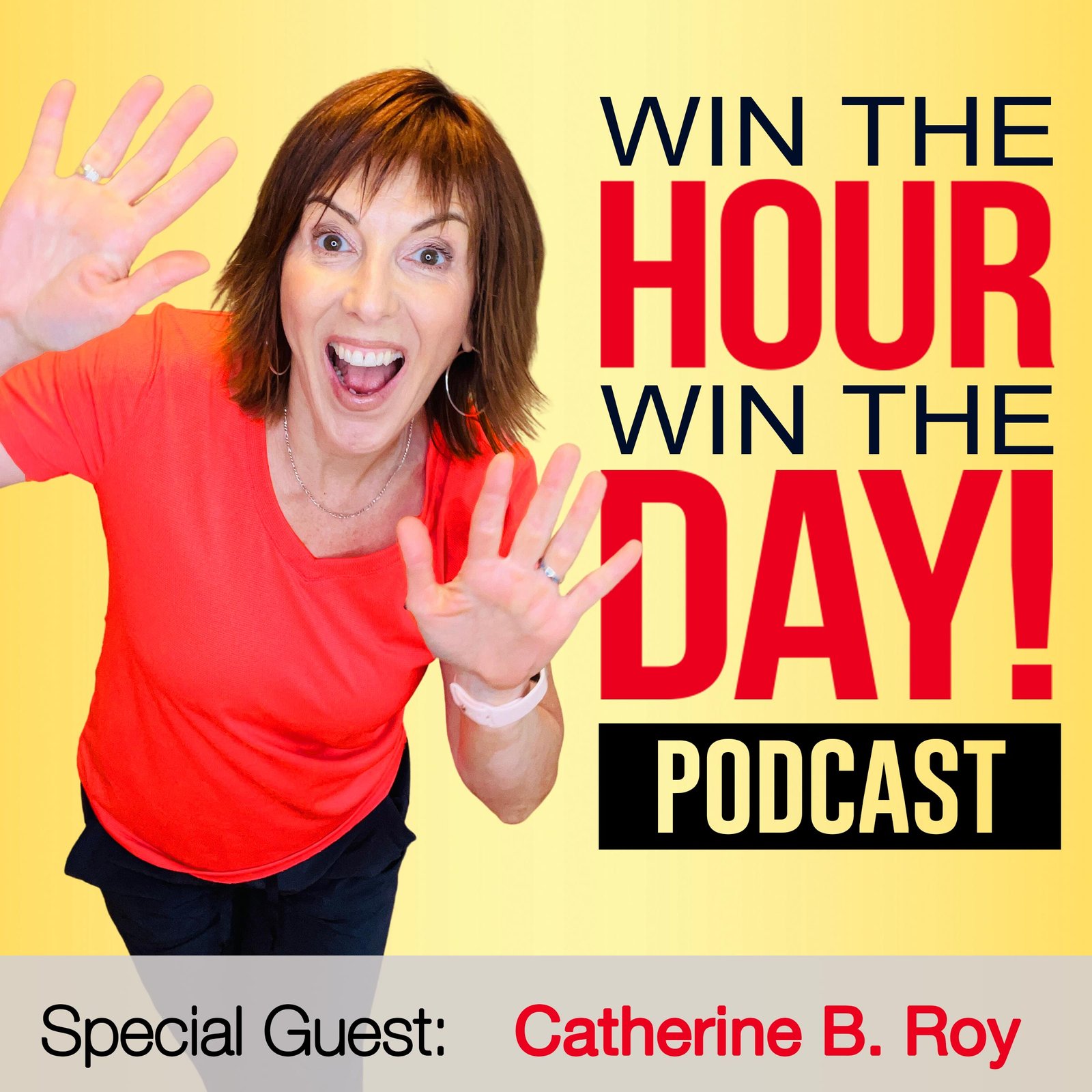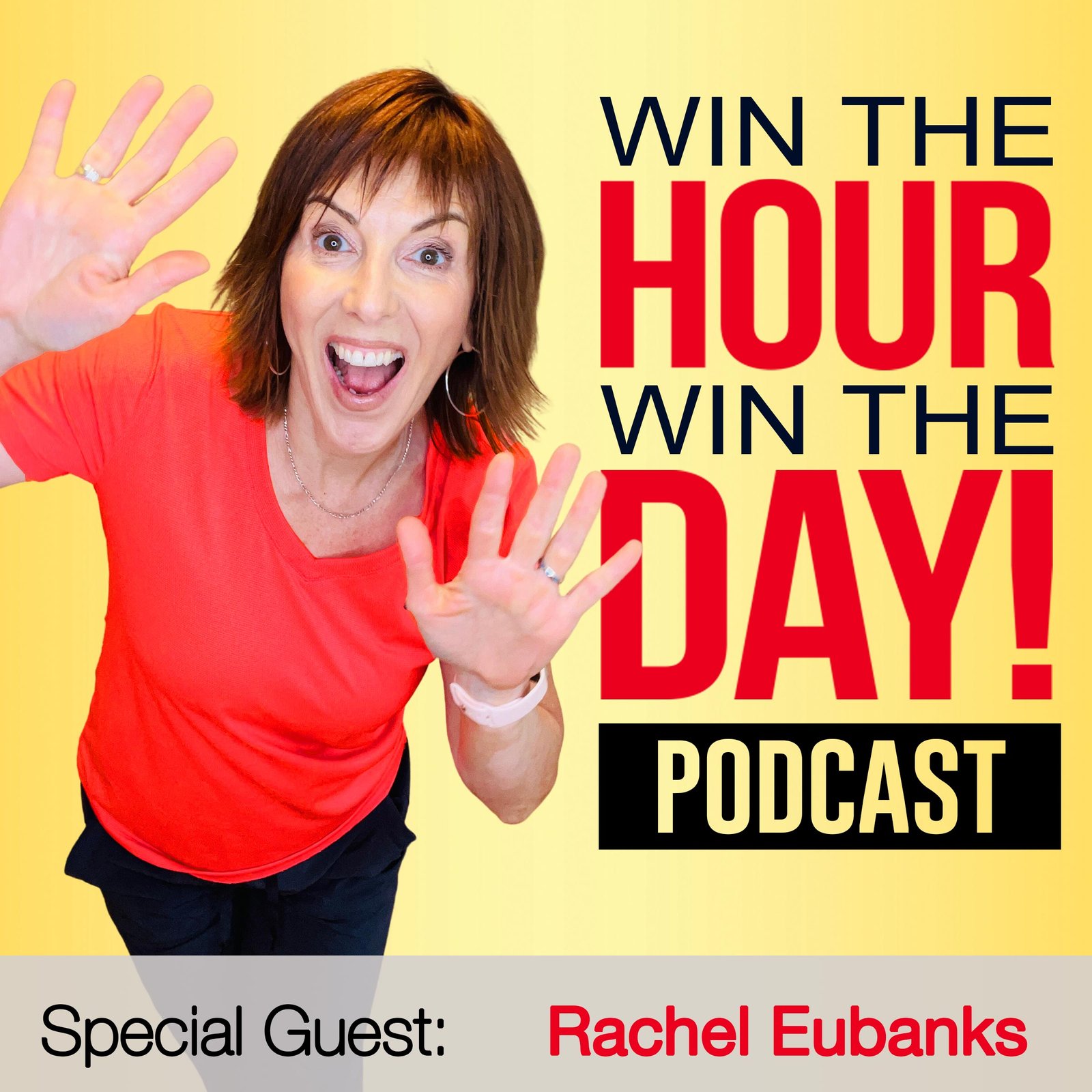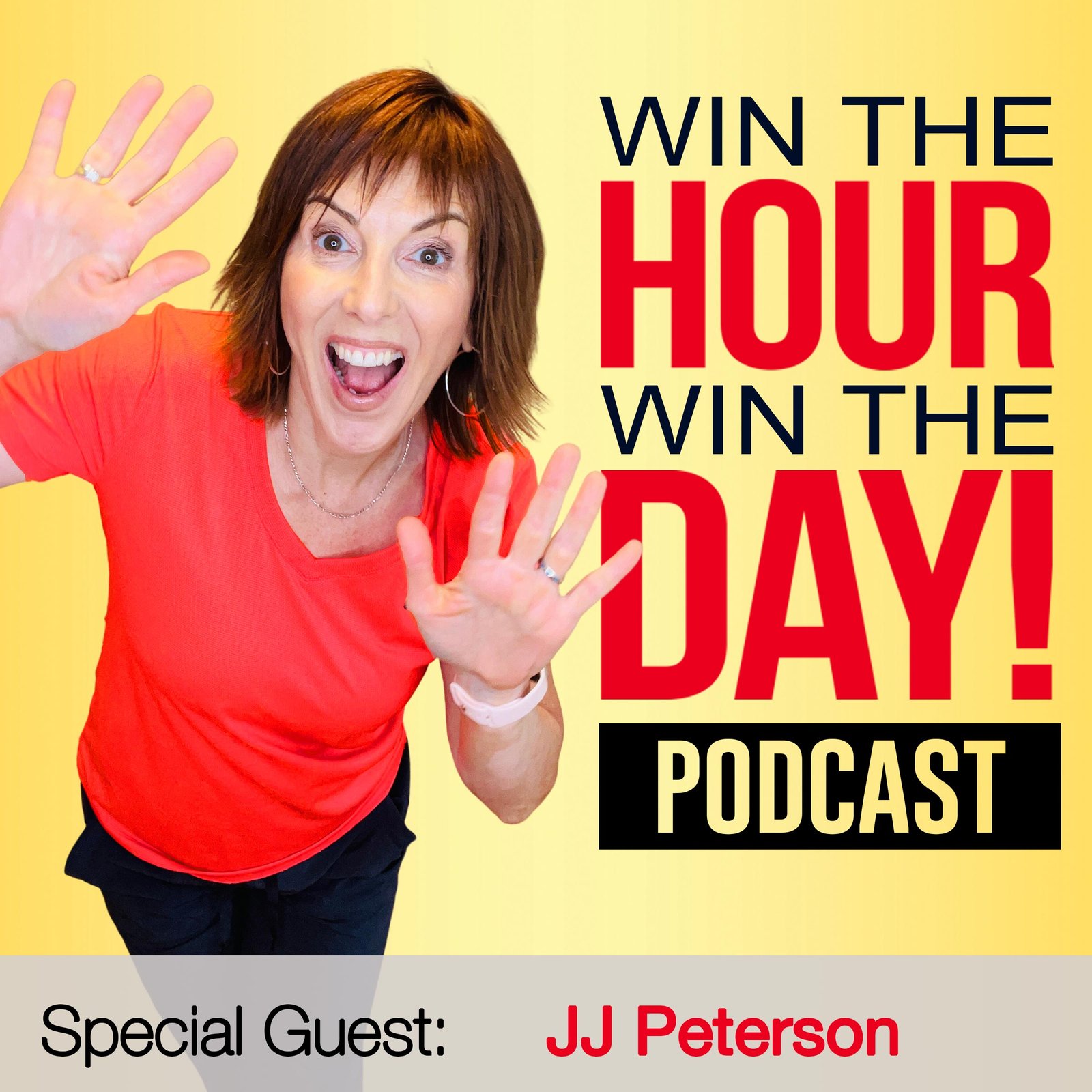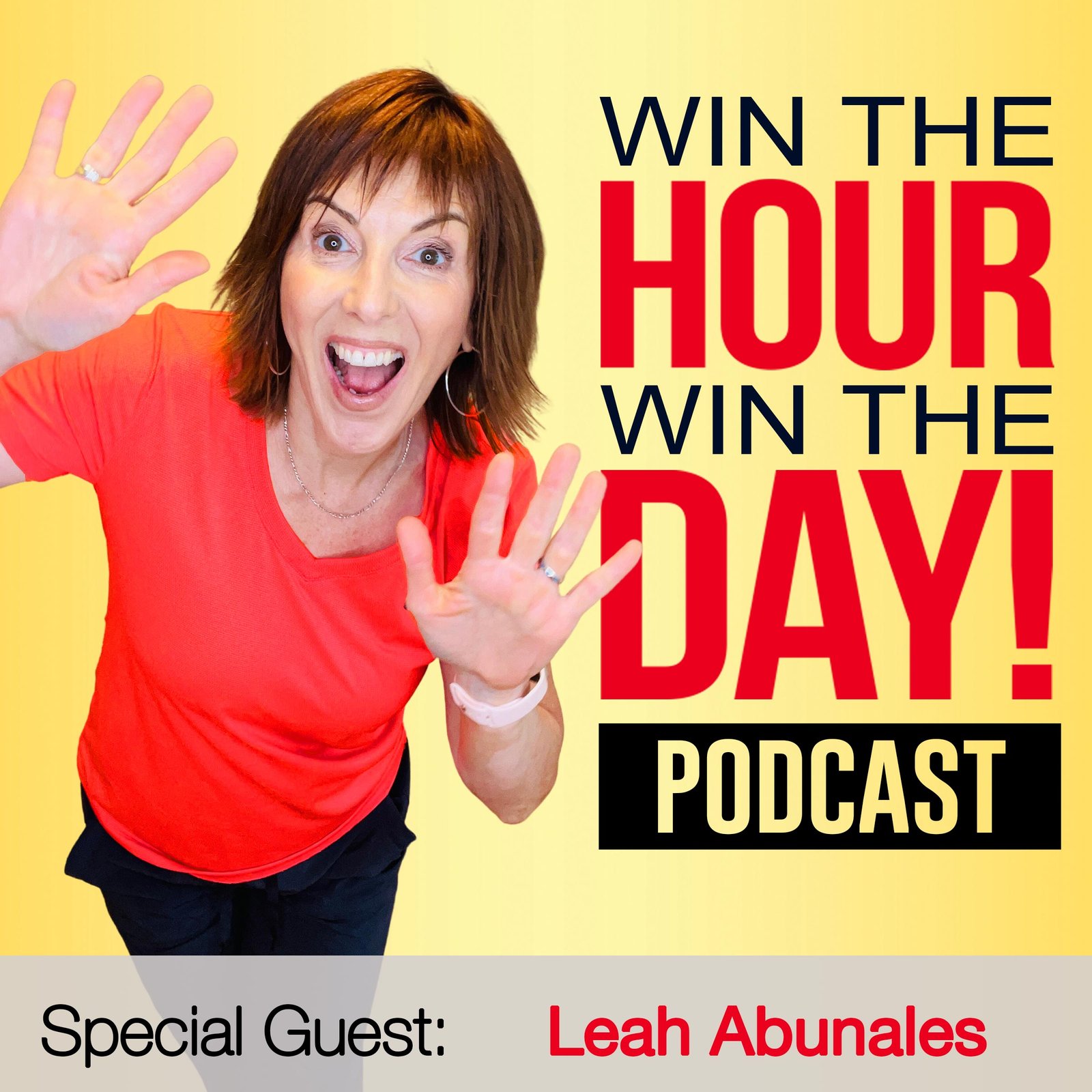Episode Summary This week’s episode of Win The Hour, Win The Day Podcast is...
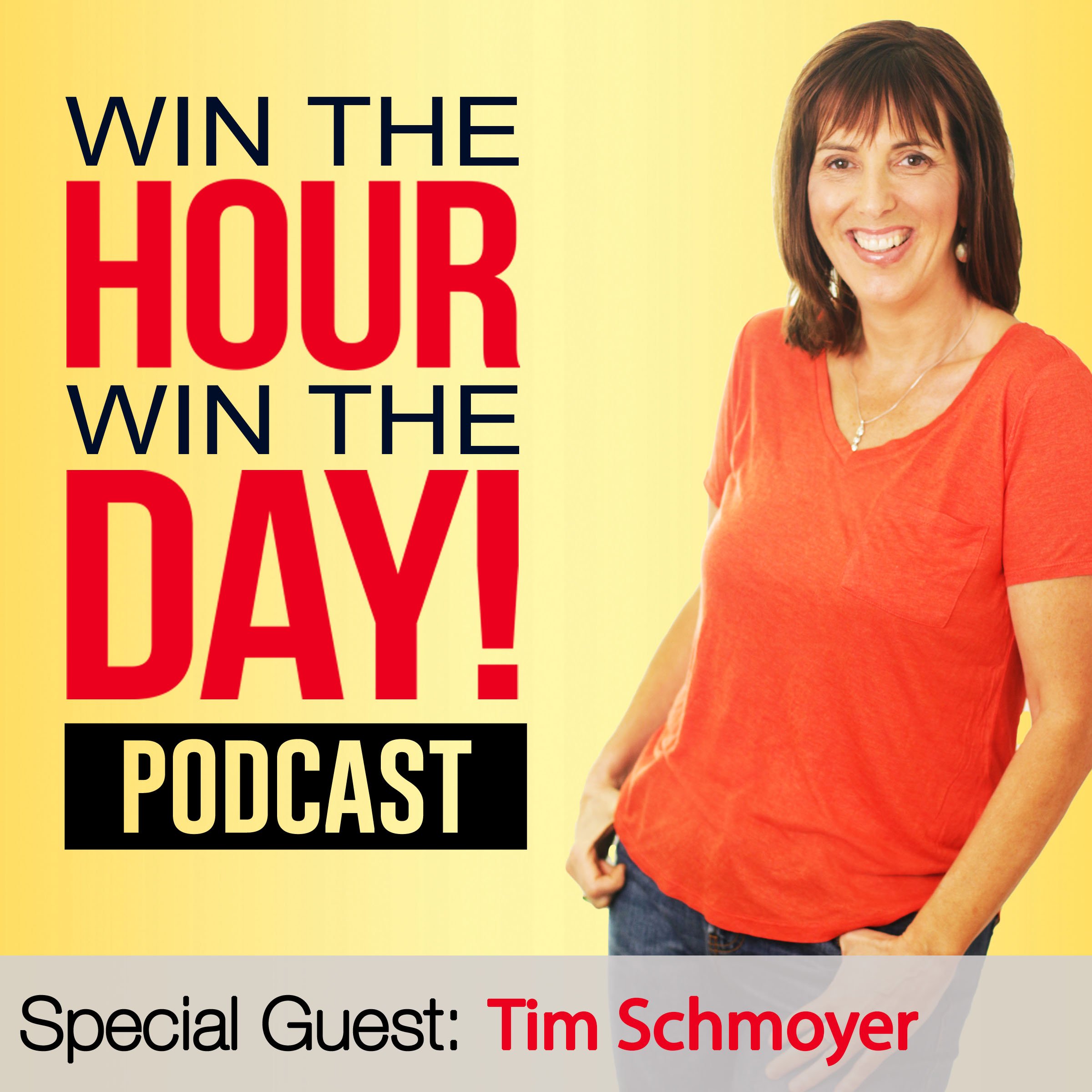
Are You Ready For Your Next Big Win?
Know your entrepreneur personality and I’ll take it from there!
Recent Podcast Episodes
Preventing Burnout with Smart Work Tools! with Kris Ward
Episode Summary This week’s episode of Win The Hour, Win The Day Podcast is...
Master Social Selling: Heidi Medina’s Strategies for Engagement
Episode Summary This week’s episode of Win The Hour, Win The Day Podcast is...
Boost Productivity and Master Storytelling! with AmondaRose Igoe
Episode Summary This week’s episode of Win The Hour, Win The Day Podcast is...
Master Video Marketing: Top Tips for Entrepreneurs with Dan Bennett
Episode Summary This week’s episode of Win The Hour, Win The Day Podcast is...
Boost Your LinkedIn Strategy with AI Tools for Enhanced Productivity! with Joe Apfelbaum
Episode Summary This week’s episode of Win The Hour, Win The Day Podcast is...
Mastering Personal Branding with NLP Techniques! with Olesija Saue
Episode Summary This week’s episode of Win The Hour, Win The Day Podcast is...
Innovative Lead Generation and Email Automation Secrets with Jennie Wright
Episode Summary This week’s episode of Win The Hour, Win The Day Podcast is...
PR Strategies for Diverse Entrepreneurial Impact! with Jennifer Singh
Episode Summary This week’s episode of Win The Hour, Win The Day Podcast is...
Convert More Clients on LinkedIn with Richard Moore
Episode Summary This week’s episode of Win The Hour, Win The Day Podcast is...
Master Business Growth on Pinterest with Meagan Williamson
Episode Summary This week’s episode of Win The Hour, Win The Day Podcast is...
24/7 Sales Boost: Video Marketing Secrets with Alex Sheridan
Episode Summary This week’s episode of Win The Hour, Win The Day Podcast is...
Master Public Speaking Tips with Nausheen Chen!
Episode Summary This week’s episode of Win The Hour, Win The Day Podcast is...
Beating The Burnout With Connie Whitman’s Success Story
Episode Summary This week’s episode of Win The Hour, Win The Day Podcast interviews,...
Craft Your Social Media Content Strategy With Shannon McKinstrie
Episode Summary This week’s episode of Win The Hour, Win The Day Podcast is...
Boost Your Productivity with AI Tools: A Deep Dive with Erik Fisher
Episode Summary This week’s episode of Win The Hour, Win The Day Podcast is...
Boost Visibility: Repurpose Content and Leverage Podcasts With Christina Lenkowski
Episode Summary This week’s episode of Win The Hour, Win The Day Podcast is...
Master Personal Branding & Storytelling with Lisa McGuire
Episode Summary This week’s episode of Win The Hour, Win The Day Podcast is...
Boost Business on LinkedIn with Catherine B. Roy’s Strategies
Episode Summary This week’s episode of Win The Hour, Win The Day Podcast is...
Scale Your Business: Optimizing Virtual Assistant Services with Kris Ward & Rachel Eubanks
Episode Summary This week’s episode of Win The Hour, Win The Day Podcast is...
Affordable PR Mastery: Crystal Richard Unveils Modern Techniques
Episode Summary This week’s episode of Win The Hour, Win The Day Podcast is...
Mastering Business Storytelling with JJ Peterson’s Guide
Episode Summary This week’s episode of Win The Hour, Win The Day Podcast is...
Revamp Your About Page: Guide to Personal Branding
Episode Summary This week’s episode of Win The Hour, Win The Day Podcast is...
LinkedIn Mastery and Video Marketing Secrets with Alex Sheridan
Episode Summary This week’s episode of Win The Hour, Win The Day Podcast interviews,...
The Systems and Processes Playbook: Insider Secrets to Streamlining Your Small Business with Leah Abunales
Episode Summary This week’s episode of Win The Hour, Win The Day Podcast interviews,...
The Secrets To Reaching Your Audience On Youtube! With Tim Schmoyer
Episode Summary
Tim Schmoyer’s clients have organically grown by 14 billion views and 61 millions subscribers under his team’s guidance. Tim started out using video to share stories with his family back home. Join us as Tim shares how you can grow your business easily using Youtube.
Learn how:
-simple it is to get started
-how you already have everything you need
-the most important thing every video needs
Join The Community: https://www.facebook.com/groups/WinTheHourWinTheDay/
Win The Hour, Win The Day! www.winthehourwintheday.com
Podcast: Win The Hour, Win The Day Podcast
Facebook: https://www.facebook.com/winthehourwintheday/
LinkedIn: https://www.linkedin.com/company/win-the-hour-win-the-day-podcast
You can find Tim Schmoyer at:
His website https://videocreators.com/ and get a free guide
Podcast (every Tuesday) – https://videocreators.com/podcast/
iTunes – Video Creators https://podcasts.apple.com/us/podcast/video-creators/id1073455415
YouTube: http://www.youtube.com/videocreators
Twitter: https://twitter.com/timschmoyer
Instagram: https://www.instagram.com/timschmoyer/
Don’t miss out!! Get on our waiting list for The Outsourcing Playbook For Busy Entrepreneurs. More Results Less You! https://www.comingsoonfromkris.com/
Tim Schmoyer
Timestamp starts – Kris (16:28):
Hey everyone, it’s Kris Ward from Win the hour Win the day and I am super, super excited about today’s guest is going to be a treat. I am not kidding you. Tim Schmoyer is in the house and it’s going to be just chalkfull of information. You want to pay attention. If you’re driving, you probably want to pull over and start making notes because that’s what I had to do when I was sitting in his audience. It was crazy. So let me tell you a little bit about Tim. Tim’s company. Video Creators has been featured by Fox, Forbes, BBC, and even YouTube themselves as his team trains other creators and business leaders to master the YouTube platform and use it as a place to spread messages that changes lives. Their clients have organically grown by 14 billion views and 61 million subscribers under their guidance. Today e lives in Cincinnati, Ohio with his wife and brace yourself. Seven children, seven children. Welcome to the show, Tim. I don’t know where to start. I don’t know where. I’ll just start with the seven children or your phenomenal, phenomenal history with YouTube. So welcome. Thank you. It’s good to, it’s good to be here and hang out with everyone.
Tim Schmoyer (17:39):
I’m excited to talk. I do like talking about children and in YouTube. So either one is fine with me.
Kris (17:46):
Okay. I was honored enough to see you an event and there was a number of people speaking, you know, about social media and a number of people in a row were speaking about YouTube. And as I said to you that day, Oh my gosh, the guy after you, he was great, but he did get the short end of the stick because it was just, it was not fair to have followed you. And I learned so many things from you and if I can, um, get you to tell us a really short version of how you got into YouTube, because for me there was a profound takeaway there and I’d love our audience to hear it.
Tim Schmoyer (18:19):
Yeah. I started on YouTube. My very first video was March 2nd, 2006. I was in graduate school down in Dallas and had just moved there and I started dating this girl and one of the, a simple way of introducing her to my family back home in Philadelphia area. And so I was like, Oh, maybe I can figure out how to make a video or I can take some photos off of this eight millimeter camera that you remember the ones that you use, like plastic ribbon tape dinosaurs roamed the earth. Yes. Yeah. And I was like, could I figure out how to do this? And, and so I put up this like 32nd videos called test video. So you know, I put a lot of creative energy into this thing. And uh, at that point blogging wasn’t a thing. YouTube wasn’t, it was just like no one even heard of it.
Tim Schmoyer (19:07):
It had just launched a few months prior. And so my girlfriend and I started just making videos of us going out on dates, going out to eat, going out to the park, going up to this, it’s like hanging out. And I would use free windows, movie maker software is the only thing I knew or how to figure out how to use it. And, and I would make these, what today would be known as blogs, but back then that wasn’t a word. We were just being awkward in public with a camera. So we would hang out and it goes via as a post them online, share the link with my family. It was great because they could just click on a link and click play and watch. They didn’t have the download this mov file from email attachments and everything. So, uh, and then this weird thing started happening where the YouTube channel started.
Tim Schmoyer (19:52):
Uh, so other people started watching and I was like, Whoa, where are these people coming from? Why are they watching me? Why, why are they coming back? And I was a little concerned because back then for a member, my space days, you don’t use your real name on the internet. If you do, people hunt you down and kill you for some reason. And so I was kind of concerned like who is Catholic or 72 and should I be concerned that they keep commenting on my, on my videos? How are they finding me? Well other people are apparently asking some of those same questions around that time. And there was no industry yet, but it was just like us getting together. And trying to figure this out. And people were like, I don’t know, Tim, we figure it out, let us know because we’re, we’re all in the same boat.
Tim Schmoyer (20:32):
So I like a good challenge. And I like trying to figure out how systems and processes work. And so I started learning one thing and another thing and started teaching it to other people. And uh, what I really loved about it is that within a few years where my wife, we got married, so I married that girl and we’re still making videos. So if like our wedding or honeymoon or our engagement, our first kids, first house, everything. And we were talking about a million people a month, which back then was way more than it is today. Yes. Huge. And what I loved about it is that it was, we were seeing in my real job as a youth and family worker, I love seeing people’s lives change, but I’m seeing more of that happen on YouTube than I was seeing in person. Literally meeting or a million people a month. And hearing stories about people who didn’t commit suicide because of videos that we made, marriages that were being healed that or headed towards divorce because of videos. We made people who didn’t grow up with a mom, but because of watching our videos, they feel like they know what it takes to be a good mom and a good wife one day and you know, I’m getting married next month. There’s thanks for making your videos…what is happening.
Tim Schmoyer (21:44):
So, um, I figured if I really wanted to reach people and change their lives, then YouTube was a platform that was perfectly positioned to help me do that better than anything else I was, I could think of. Uh, I love podcasting. I do have my own podcasts and things now and things to do, but I, what I love about YouTube is I could make someone like not just show the talk with them. I could like show them, make them feel like they’re having the same experience with me in that moment. And I know a lot of people are really good at doing that on podcasts and such. I don’t think I’m one of them, but on YouTube this, the amount of impact it was having was awesome. So fast forward, um, lost a few jobs, got fired from one and were laid off from another one and I was like, screw this. All right, I’m going to do for myself. But I’ve been teaching other people to do with YouTube, started video creators in 2013 and within six months it was my full time gig and today it’s not only family but yeah, there’s a team of nine of us now. So it’s a small team but we’ve done strategy now YouTube Chaterjee for Disney and Warner brothers and HBO and we did the Batman release for Warner brothers and just like all these big brands,
Kris (22:59):
So many things I want to unpack with you. So many, but I guess [inaudible] and I said this to you before you even started. I think the biggest thing for me I, it’s really quite ridiculous. I don’t even know why you said yes to coming on because I have like little to no like nothing on YouTube really. And because I always thought, no, I, I then, yeah, for now I’m telling you, cause I’m drinking the Koolaid people. I, I thought it was like very clunky, uh, more technical and it’s almost like a webpage if that will have to have all the backdoor stuff done correctly. And so you always put off learning that and then we all get in our own way. I do anyhow. And I think, well, you know, what, what’s my behind the scenes stuff or what’s my story? Is it good enough to put out there?
Kris (23:44):
I don’t think doing anything particularly interesting. And you know, cause a lot of my work is at my desk. So I thought, well how are you gonna make that fancy and start over producing boring videos of me at my desk. And so what I got where, where I really became awakened from your story and, and, and this is the, you know, the short version and then you go on to impress us with so much YouTube knowledge is just that you were out there. It’s kind of like law, the law, nonchalant telling his story. And I think because you weren’t producing the story and because you weren’t like invested in the outcome, you are more sincere in it and then all of a sudden you just have this audience. Like it was so meaningful because it was real. And yet the rest of us are all trying to think of how can we make this exciting, interesting, a Hawk and make it real and then you are yours exploded just because it was a real story about real people.
Tim Schmoyer (24:35):
Yeah. Yeah. I actually do that on purpose. So it’s not accidentally, it’s a, yeah, there’s a, there’s an element in, um, in branding called, um, it’s from a book called primal branding, but he talks about how it’s really important for people to care about what you’re about to say, that they needed to first know who you are and where you’re from and how you got here. Because no one really cares much about what you can sell some Fossey like, you know, we’ve done 17 billion organic views, 71 million subscribers for clients, stuff like that. But, but that doesn’t get human emotion involved. And most people just trying to convince people that I’m an expert when really like if you want people to create a human connection with you and then really love your brand, you just, they really need to know your backstory. So that’s part of why I did that.
Kris (25:20):
Okay. So yeah, but it happened sort of like, like now it’s purposeful, but back then you were just kind of doing your thing and I think the beauty of it was, yeah, the beauty of it, it unfolded because there was, you weren’t invested in the outcome and because you were unknowingly or, or without any sort of intention of just telling a real story about a real journey and people got invested.
Tim Schmoyer (25:41):
Yeah, there is no money on YouTube at the time. It was literally just me liking a good challenge and wanting to introduce my girlfriend and my family and that started the trajectory.
Kris (25:52):
So then tell us for us, I mean I sometimes I feel like we’re late to the game. What’s the point now? All this other stuff. Tell us where we get in our own way. What is something that we could just start off simple and basic without overthinking it for YouTube,
Tim Schmoyer (26:08):
I think if you’re just starting out, the main advice I have is just to keep going and don’t worry about quality, don’t worry about growth, don’t worry about gear or equipment or anything cause that that gets, that keeps people from actually even starting, like they don’t even get to one, like they’re just stuck at zero. And the truth is you have, if you have a cell phone, you have everything you need to just go from zero to one, like just get started. So let all that stuff hang you up. And not only just because it keeps you from getting started, but really what most people don’t realize is that most creators have a lot of mistakes that need to burn through before they even come in to experience growth in the first place. And you don’t want the making those mistakes in front of a large audience.
Tim Schmoyer (27:01):
You want to make those mistakes while you have no one watching. So the, the goal when you’re first starting out, I don’t think is to every video need to do it. It needs to be getting views. We need to be getting traction. Why am I not getting momentum? I’m putting so much work and so much energy into this thing. Why is it not working? And as soon as you get caught up into that, if you think the goal right now is to get views, you’ll be very disappointed. Not because it’s not possible, but just because you got a lot of processes and systems and things, you got to figure out who is my audience? How do I talk to them? How w at what point do I start feeling comfortable on camera and editing videos and having a consistent workflow. Like these are all things that are way more important to figure out in the beginning before we start thinking about momentum on the platform. It’s just like, like if before you, you don’t jump in and swim a race, you got to learn how to swim first, right?
Kris (27:53):
No, and that’s such common sense. And I tell people that all the time too. Like, great, we’re making mistakes. We have no audience, and yet I know that. I know that I’ve learned it over and over again and I know it on this platform and that platform, but then you, you’re right, you come to YouTube and all of a sudden the amount of stuff I could learn and research on just thumbnails, you go, Oh my gosh, I don’t think I need to get a degree in thumbnails. So before I can make a video and then always it just a talking head and how much do I share and how do I not present and then let people into my world. Do I need to have a better kitchen? Do I have to buy a new house so that the shots are better and you do, you spin out of control because it does seem to have, it’s such a robust platform that I do think you get caught up in everything that’s going on.
Tim Schmoyer (28:38):
Yeah. It’s just, just get to the basics. Be like, how do I go? I’m at a zero just as published a video that’s a one. And if you’re a currently publishing at a one, like I’m using my, my mobile phone and I got some editing down, I got some some processes down. I’m feeling comfortable on camera. Okay, well let’s talk about what it goes takes to go to a two that maybe, maybe you need to figure. Usually at that point now it’s figuring out how do I come accurately and clearly and quickly communicate my brand. Who am I? Who am I, what am I all about? What value you’re going to get if you’re here, who was just for it, you know, those type of basic branding stuff. But yeah, don’t chunk to like I’m going to become the next Mark Rober beauty pie or like perfect or whatever. Just because I published a few videos.
Kris (29:23):
Yeah. So okay. With all the vast knowledge that you have, cause I’d like to know if I knew as much as you forgotten, I would just really be exactly static with life. Not too much. So with what, you know, give us, let’s say the top three that we need to focus on to say, okay, we need to get this machine off the ground and start. So go from zero to one and then what’s some other things that we can do to either get going or are not get in our own way. What are some wins we could get
Tim Schmoyer (29:55):
in, in terms of getting momentum and viewership on the videos?
Kris (29:59):
And in terms of anything, what, what is it we should be looking for? Where should we be starting?
Tim Schmoyer (30:05):
I think after you have some videos on your channel and, and I’ll put a number on it necessarily, but it’s not just one, it’s more than one. It might not have the be 50 or a hundred. Although some, uh, one friend of mine, now he’s got a couple of million subscribers on YouTube. He made 750 videos before he felt comfortable watching his first video back. Like he couldn’t even watch his videos afterwards. You would just shoot and then publish and he wouldn’t watch them cause he just felt so, he felt so uncomfortable. So for some people like him, it took him 750 videos before he would even watch one without cringing or even get to that point. So, and now he’s got a couple of million subscribers and you know, he worked past that. But uh, not, not everyone’s at that point, but some people are. So really it’s just, it’s not really a video number count necessarily as much as it is.
Tim Schmoyer (31:00):
All right. I feel like I’m hitting my stride here. Finding advice. Yeah, exactly. Yeah. I’m, I feel good about what I’m communicating. I think I’m delivering good value. And so then after that, the next thing is, is really defining and communicating your brand. And by brand I don’t just mean here’s our logo and our website URL. What I mean is when people find you, how do you make them feel? It’s like if you want people to watch your videos on YouTube, you’re likely not the first person to make a video on any topic you make. Now there’s, there’s likely someone else has already made that video or talked about that topic. Maybe not from your perspective or with your story. And your background, which is all makes it very unique, but in terms of getting them to click like they don’t know your story, your background, you got to get them to click first and so that really comes down to and so on.
Tim Schmoyer (31:53):
First starts watching your videos, how quickly can they determine like how quickly does it make them feel like, Oh yes, this video is for me. Where have you been my whole life? This is exactly what I’ve been looking for. Even before we started recording here, Chris, I was like, okay, who’s the audience here? Who are we talking to? So that when I share examples and share ideas, I can talk to exactly where you are. You’re a subscriber, you’re your listing or your audience is at so that they know to go next. If I, if this is an audience of let’s say subscribe channels who have multimillion subscriber channels, we’re going to talk about this very differently than if it’s YouTube creators. You are just getting started. So the same thing is right with same thing is true for your viewer. If where are they at in their journey? What do they want as a character in their story? What are the obstacles that they’re facing that they can overcome? And how can you position your brand to be the guy, the hero that equips the hero with a proverbial sword to overcome this roadblock that they’re facing in their, in their life. And that’s why they’re going to watch. So we need to communicate that immediately upfront so that this best person to be like, Oh, this is for me. It’s got my attention, I’m in the right spot. I want to keep watching.
Kris (33:07):
And I will tell you when he asked me that before we started, I was like, Oh yeah, I forgot cause I was so excited you’re here. I was like, okay, nevermind. Let’s just dive in. Don’t ask me intelligent questions. I’m just excited to see,
Tim Schmoyer (33:17):
Oh no, it’s fine. Yeah, it’s just, it’s just important not only for, it’s for everyone. Like if I want to see if I’m going to consume content, I first need to know if it’s for me and the second I need to know, do I care? And so that’s where the human emotion part comes in with our stories and the way we present ourselves. And, and uh, and even as do I care, is this going to be helpful for me? Like, okay, yes, I know that you’re making this video for me, but is this something that I’m like, that I actually care about and that’s going to keep my attention.
Kris (33:47):
So if you were going to go all in and get this, you know, like let’s get this plane off the ground, would you recommend like, okay, just keep doing, shoot a video every day cause you, the more you, you know, the more you do, the better you’ll get at it. Like this guy doing 750 videos, like how long did that take? So should we be like, what if I know everything is totally different. There’s no best practices, but I guess the more you do, the quicker you get there. Really. Right.
Tim Schmoyer (34:11):
That’s all right. Yeah, I was just like, anything, the more you practice, the better you get and then you kind of hit a stride and then you get stuck in a rut. And then you got to relearn everything again to keep the momentum going. So yeah, it’s just that same
Kris (34:24):
now with the story and you want to make people feel things. This is a part I’ve always struggled with and, and when I built, when the hour, when the day platform that was actually built, um, it’s productivity, but a big under the umbrella of productivity, but a big, huge part of it is, uh, leverage leaning into your team, building a team. So many people think they can’t afford a team or it’s too much work, all that stuff. And that kinda came to light because of my marketing agency. I’d been pulled away for two years from my marketing agency because my husband had been diagnosed with colon cancer. And when I returned after his death, my clients were shocked. They did not know I was away because the things we had in place with a team and they asked me, how did I do that? And so, you know, then I of course had a renewed commitment to life and that business should be fun and your business should support your life and not consume it.
Kris (35:12):
So I wrote this book Win the hour Win the day, and I help people with that now. Now for me, in the beginning it was really hard to talk about that. Not because of the emotion or anything, but because I just felt like everybody has a story and I didn’t want it to come across, you know, whatever. Like I that everybody has something. That was my something right now. So people kept pressuring me. Like without that Chris, it’s just another book, right? So I’m like, okay, I’ll talk about that. But when I do that, you know, that’s the thing of where I don’t, what I find is when you go into YouTube, you start going into teacher or preacher or, or showing mode of like, here’s how you build a team and here’s why you build a team. And I totally resonate with what you’re saying with the feeling part, but where does that weave in and out? Because that’s not a story I need to share every time I shoot a video. Right. That’s where I get lost.
Tim Schmoyer (35:59):
Yeah. My guess is that you have a way many other stories besides that. Right? A story and a significant story, but you’ve had plenty of other experiences that can tie into the thing that you’re talking about in that video. So I’m not necessarily saying like, let’s say this is a, I don’t know how to do one hour a one hour’s work in five minutes, for example. You might have a story about that. That doesn’t mean you’re going like, so guys, here’s what I did. I had this experience or I did blah, blah, blah, blah, blah. And the people were like, I don’t care, just tell me how to do it right. And there are certainly cases like that. Like for me recently, my alternator, I had to replace the alternator in my Lomar, so I don’t want to hear someone’s story and that, you know, I’m like, just tell me where to screw this and unscrew that and replay like whatever.
Tim Schmoyer (36:54):
And those types of channels, if that’s the approach, you take the content, you can get views that way, but it’s harder to build momentum with fans. Like someone in that case is going to come, how do I do five minutes or an hour of work in five minutes? Oh, I got the information that was great and then they’re going to leave and they won’t even remember you or your brand, who you are or even how to find you again if they wanted to write that though. As soon as you start building human connection where you giving them what they want and then you slip in stories and start both. But that’s what it’d be like. Oh, and I kinda like this Chris lady. Like I feel like we could be friends. I feel like we could hang out. That’s when that proceeds relationship starts to take place is when people more liberal, more liberally subscribe.
Tim Schmoyer (7:373):
There’s going to be more likely to give you more watch time to watch more of your videos. And so you can get them there with the content and you should like start off your videos affirming that, you know, here’s what, here’s the problem we’re going to solve for you today. But somewhere towards the middle or end of that content. If there’s an opportunity, we can slip in a, uh, one of your stories that that would help the right content. Not really super long, right? Don’t take no in 15 minutes, but you’re like, Hey guys, I know this is like, I felt this too. Like there was a time when I, and this is what I was facing, I didn’t how to overcame it and then this or comment this thing happened and that’s exactly what I did. These are the results I got and I think you can get the same results too.
Kris (38:17):
Right. Okay. That’s really good point. Cause again, you get lost in all this dough. You have to tell the story. I don’t wanna tell my story. Okay. Tell the story. Where do I tell the story? How big of a story? So I, I tell you, here you, that may be something like whatever, if I felt the need to share it, it could be on the main page of how I, my journey started. But then the stories throughout it could be like, Oh yeah, this is what happened this week. I even fumbled cause whatever something happened in my schedule. Okay, perfect. Now
Tim Schmoyer (38:41):
it says a tutorial drawing channel and he hit normal videos. We get like 10 to 20,000 views. And we worked with him a that and he was like, okay, no, start this video. He started, it was just a normal drawing tutorial about how to draw face. And it said the only story, it was only like two sentences long is how he opened his, his, his, uh, his, his video, which he said something like, um, a lot of people are, it’s really hard to draw a face. And my wife just said like, she could never do that. She never thought it was possible. Maybe you feel the same way. And then the rest of the videos, his wife sitting down and him coaching her how to draw, how to draw the face, like two sentences sounds a little bit of a story. Here’s a character who wants something.
Tim Schmoyer (39:25):
Does she get it? I don’t know. There’s this big obstacle in the way and this, but there’s this guy coaching her through. So it’d be, that would’ve been way different. And, and that would be way different than if he had just been like, here are boys and girls. First you draw here, then you draw a line there and just like stuck to the details. But because they brought in the human emotion, then that video instead quickly went to 850,000 views and it’s still getting momentum just with that, those like little tweaks. So it makes a big difference.
Kris (39:53):
Oh my gosh, you’re lucky. I don’t know where you live. I think I drive there. So yeah. So you know what? There’s so much. Uh, as far as like, I know you said just you got your phone, don’t get caught up in the tech and your messaging so far is so simple, but hugely powerful. Like I’m learning a lot. So I’m sure my audience is too. When we do say, okay, if we have one thing to focus on one little zone, when we get our momentum, we get our voice, we do all that. Where do you think that we should start? What’s that one little thing of women you’re ready to get in there? Is it the keyword tags? Is it the thumbnail? What does it or does it matter again?
Tim Schmoyer (40:32):
No, it does. Uh, so step one to get started, step two is hone in your branding in terms of target audience and the value that you’re pitching value proposition. And then make that super clear to a very first time viewer. The next step after that then is the, the order that the, well the principle is you gotta start with an opening hook. Okay. And the hook isn’t necessarily the opening seconds, it’s actually the title and thumbnail. So the process most people go through is they come up with some good ideas and like, okay, this is the content they S they, they shoot it, they’re editing it, and then while the video is uploading, so thinking, what’s, what titles should I give this thumbnail said I give this and, and then you might put something in that’s accurate, but it doesn’t actually, it doesn’t actually maybe tie in with the first opening seconds very closely.
Tim Schmoyer (41:25):
So you need a title and thumbnail. Main principle is that you elicit some sort of reaction. So I’m sort of like, it creates some sort of in the brain that the brain is like, Oh how does that happen? Or does that really work? Or what happens next? Something that Chris intention and that usually revolves around pitching value, pitching reward. Not necessarily getting the right keywords in the right place but but teasing a solution to a problem that that their target audience has and so as best instead that if you, before you even shoot and when you just ready to start getting momentum, you first determine what the title and thumbnail is going to be before you even shoot. Cause that’s really the best way that you can now open that content to affirm for the viewer immediately like, yes, what you clicked expecting to get is coming in this, in this video.
Tim Schmoyer (42:17):
Otherwise, if the title of thumbnail is about something that happens like eight minutes in your first time, your first time, viewers are all going to abandon that content. They’re not going to stick around for eight minutes to CFF incomes or not. So when you know the title and thumbnail is before you even shoot, then when you press record, you already know what brought them to the content. And now you can start like taking that tension and like in stretching even further, increasing the tension so that now they’re like, Oh my gosh. Like, yes, I have to watch this whole video.
Kris (42:48):
Oh my gosh. Now do you, can you watch youtube? Like where are you in the YouTube scale? Can you watch it and enjoy it? Or do you get sucked in longer than us? Or you get sucked in less than us because you know how to bug that won’t work. This isn’t going to be interesting. Like, where are you in this YouTube addiction?
Tim Schmoyer (43:04):
Um, I watch YouTube a lot, mostly for work these days. Cause I watch, I make a living on YouTube, you know, and then after work, I don’t really tend to have as much of my own, like, uh, just gonna catch up on my favorite creators. I’d certainly do have my favorite creators that I catch up on. But that part that you’re talking about, the analysis part happens all day and then I can’t really shut it off. So my wife hates watching TV shows and movies and stuff with me because I’m like, Oh, like now that I know how stories work and things and like I totally know like 15 minutes into this, I know how it’s gonna end or no, that character can’t be the next one to get voted off the Island because they opened the story like this and she’s like, stop it. You’re ruining him for me. And I’m always right.
Kris (43:54):
Oh my gosh. Okay. That’s awesome. All right, so I don’t want to take up too much of your time. What would be the last thing that you need to tell us that you know, I hope we didn’t, I don’t want to say waste your time, but you have such a vast knowledge that the simplicity of your message is so powerful and yet there it’s like an ocean in a sea. It. There’s, it’s so beautiful on top and yet I know there’s so much underneath there too, so
Tim Schmoyer (44:16):
you know people get hung up on is all the algorithm, keyword tags stuff and people spend an enormous amount of time focusing on that stuff. And I think if I remember correctly session that I did at social media marketing world, I actually went in and showed you guys a little bit, here’s how the system works and why your tags don’t matter and why your keywords don’t really matter. I mean they do, but more from the human perspective of what expectation do these words set for the viewer. You could have all the perfectly correct keywords crammed into all the right places and if it doesn’t elicit some sort of emotion or curiosity or tension, no one’s going to click. It doesn’t matter how busy in the content is. So the, the metadata really is, which is the title and the keyword, the tags and the description texts and all that stuff really doesn’t have nearly as big of an impact on performance on YouTube as does the someone, when they watch it to someone wa actually spend a lot of time watching this video.
Tim Schmoyer (45:20):
Do they watch more videos after this video? Do, are they satisfied? YouTube will pop up sometimes satisfaction ratings and they’re like, maybe you watched it, but how did this video make you feel? And they want to know it’s all about human signals. So we should be focused on the same thing that YouTube algorithms are focused on, which is not as good as the rudimentary days of keyword matching ended in 2012 with the switch over to watch time. So, so it’s 100% now about how do we optimize for people not for robots. And the better we optimize for people, the more our videos will perform.
Kris (45:56):
And that makes so much sense when you say that, because when you said that, I’m thinking you’re right. How many times do we all see something all over the world because you know, Oh look at this cute baby video and you send it to everybody and there’s no keywords and it’s like, you know, or that cat you showed in your display haunted me for weeks. I’m like, ah, the cat had a million views and he did nothing.
Tim Schmoyer (46:14):
It was like four or 5 million views. Yeah.
Kris (46:16):
Yeah. There was like a tension about something like it was the world’s biggest asshole cat or something and you watch it for 30 seconds. All he does is knock something over with the tail and it’s funny and it did have tension but they clearly did not put a lot of, you know, thought into the back door stuff. Where as entrepreneurs we just get so stuck like that’s me. I kept thinking, Oh well you know what’s the sense of doing this when it’s not going to matter cause we don’t know any of the backend stuff. We will get to that and then we’ll talk right, wrong, wrong, wrong. Okay. Awesome. Well, you know, you’re my first guest for me to have mentioned this before cause I had no, it’s not my job to sell, but as I was sitting there waiting for you to come on, I started shopping online and looking around and you do have an extremely loaded product for I believe like $97.
Tim Schmoyer (47:03):
Yeah. 30 days of better YouTube channels. With that is, it’s literally a step by step hand holding process every day for 30 days. You can work through it at your own pace. A lot of people go through it quickly. Some people go through a um, a monger. It’s, you can do it your own pace. But yeah, it’s every day for 30 days. We’re like, here’s a teaching, something need to know. And then two, here’s assignments. Go do this on your, on your channel now. And then three, there’s links to further resources and videos that we’ve done and other articles if you want to dive deeper into that, into that issue or that topic. So it’s like step one, step two, step three, everything you need to know and do to make a highly subscribed bubble channel, optimize it for growth.
Kris (47:46):
Awesome. Well he is the guy, ladies and gentlemen, if you’re looking for anything YouTube, it’s video craters. Tim, is there anywhere else that they should look you up or like just go to the obvious, go to YouTube.
Tim Schmoyer (47:57):
Well yeah, you can go to videocreators.com and get a free guide if you just want to start there as well. That’ll walk you through the first six steps of how do I get started, what I need, like how do I map out a, a strategy for my channel that I work, but I also have a podcast every Tuesday and just like, I’m not sure when yours are published, but yeah, you can search iTunes for video creators and it should pop up and be and have you guys join us there.
Timestamp ends Kris (48:23):
Oh, awesome. Okay. Well I cannot thank you enough. It’s been a real treat for me and I’m sure for my audience. So I thank you sincerely and we’re just very thrilled and honored to have you here. Cause it was, it was something to watch you on stage. I mean I had notes and notes and like, Oh my gosh. So thank you again for your generosity and time and coming here and uh, thanks everyone for joining us.
